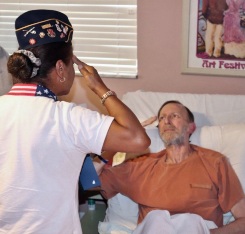What is a Do Not Intubate Order?
When patients and family members are asked about their preferences for end-of-life care, they often face decisions about signing specific documents, including a Do Not Intubate order (DNI) or a Do Not Resuscitate order (DNR).
Both orders give clinicians instructions about the measures a patient wants or does not want; for example, if they lose consciousness, cannot breathe on their own, or face other serious symptoms or complications that could interfere with long-term quality of life.
These decisions and instructions are part of a process called advance care planning. Advance care planning guides the approach to the patient’s care, particularly with regard to symptom management and goals of care (comfort care versus aggressive life prolongation).
Working together with the clinician, patients and their families decide whether they want specific treatments, such as:
- intubation
- cardiopulmonary resuscitation (CPR)
- dialysis
- artificial (parenteral) nutrition/hydration
- antibiotics
DNR and DNI orders are an integral part of advance care planning.
In medical terms, a DNI means that patients do not want a breathing tube inserted into their trachea, via the nose or mouth, to restore normal breathing. If the patient’s breathing remains impaired, the tube remains in place and is eventually connected to a ventilator to maintain breathing. A ventilator keeps oxygen flowing into and out of the lungs when patients are unable to breathe on their own.
A patient can sign a DNI and continue to benefit from oxygen therapy and non-invasive ventilation, such as through BiPAP.
Does Hospice Require You to Sign a DNI?
VITAS Healthcare does not require patients to a sign DNI order, which is usually a specific part of a broader DNR order. Hospice patients and their families understand that the focus of hospice care is comfort care, not to cure the underlying disease.
Once DNR and DNI orders have been signed, they are usually placed in a patient’s chart before a medical crisis occurs so that healthcare team members understand and can honor a patient's wishes for end-of-life care.
DNR vs. DNI: Is Intubation Part of DNR?
A DNI order is usually contained within a DNR order. The overarching DNR tells healthcare professionals not to use emergency life-saving procedures, such as cardiopulmonary resuscitation (CPR), chest compressions, breathing tubes, and cardiac drugs, for example, to revive a seriously ill patient if they quit breathing or if their heart stops.
A DNI, however, allows basic life-saving CPR, chest compressions, and medications, but specifically prohibits the placement of a breathing tube.
Why would patients opt for a DNI? Most hospice patients do not want to remain on a ventilator long-term or prefer to die a natural death. If you sign a DNR then it is not necessary to also sign a DNI.
Considerations for DNI
Keep these considerations in mind when deciding whether to sign a DNI for yourself or someone who has entrusted you to make decisions for them:
- What are the short- and long-term risks and benefits of intubation?
- Will intubation honor a patient’s stated goals, wishes, and values for comfort-focused, home-based end-of-life care?
- Will intubation support quality of life near the end of life or serve as impediment to quality of life and/or a dignified death?
- How involved do you want your physician or care team to be in your decision about DNI or DNR? Ask if you need more information about the impact of your options and decision.
- If you are serving as the healthcare proxy for a patient with an advanced illness, try to have conversations while the patient is still lucid about his/her wishes for a DNR or DNI so that you can make the right decision at a later date.
The best approach to a DNI or DNR is to begin discussions early in your own illness trajectory (or your loved one’s illness) to make sure your wishes are explored, documented, and shared with others, including with your designated decision maker(s) and your healthcare and hospice teams.
